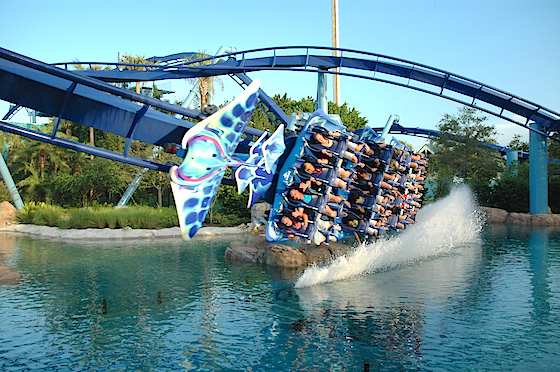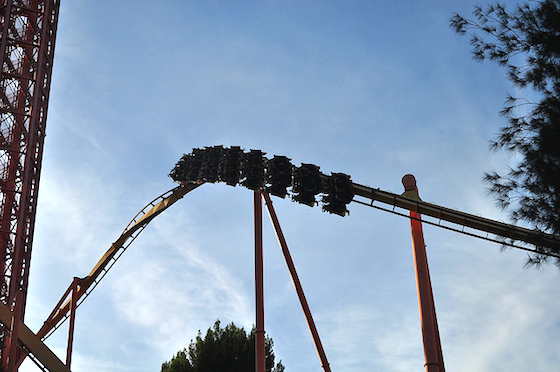At Paramount’s Great America, as it was known in 2000, Vekoma installed the world’s first flying roller coaster, called Stealth. In the year that Cedar Point and Six Flags Magic Mountain opened roller coasters attempting to establish new world records (Millennium Force and Goliath, respectively), the Santa Clara, California park was breaking new boundaries with a coaster type that would further diversify the theme park landscape. Vekoma’s creation was known as a Flying Dutchman model coaster, and has since been relocated to Carowinds as Borg Assimilator and eventually Nighthawk. While it was Vekoma’s first attempt at a flying roller coaster, it doesn’t differ much from the other two Flying Dutchman coasters installed in the United States (Batwing at Six Flags America and X-Flight at Geauga Lake, later moved to Kings Island as Firehawk). All three coasters feature trains that riders load in a sitting position, then are reclined back before leaving the station to begin the course. The biggest difference between Stealth/Nighthawk and the other two Flying Dutchman is that Vekoma’s first flying coaster has only one loading platform and a slightly shorter track. However, all three feature significant flaws. On Vekoma’s flying design, guests are restrained using a locking lap bar combined with padded, ratcheting shoulder straps that clip together like a seat belt. Having ridden all three installations, all of them have issues with the clips that lock the shoulder straps together, which can delay loading and unloading. Also, the position that riders are placed in after reclining can be extremely uncomfortable, as guests are lying on their backs with their feet and waist positioned above their head. After being stuck in the station for just a few minutes, I can attest as to how uncomfortable the position can be. However, once on the lift hill, and throughout most of the ride, the position is rather comfortable and does a very good job of simulating the sensation of flying. The other major design flaw to the Vekoma Flying Dutchman coasters is that all of the hydraulics controlling the reclining of the seats, as well as the computers controlling the locking of the training and ratcheting of the belts are carried on board the trains. Not only does this make the trains extremely heavy and robust, but it also means that those mechanisms and electronics are subjected to the same forces as riders, and that wear and tear has led to significant downtime for all three coasters. However, the Vekoma design, apart from the vertical loop, takes advantage of the rider’s flying position over much of the coaster’s course with riders facing down for nearly 2/3 of the ride.

In 2002, the masters of roller coaster design, Bolliger and Mabillard, came up with a flying coaster design that would put the Flying Dutchman to shame. With the installations of Air at Alton Towers and Superman: Ultimate Flight at Six Flags Over Georgia (later cloned at Six Flags Great Adventure and Six Flags Great America in 2003), B&M took the flying coaster design and perfected it. There are some similarities between the Vekoma and B&M designs, but the subtle differences are what make B&M’s design head and shoulders above the rest. The most striking difference is the way in which riders are moved into the flying position. On the Vekomas, riders do not experience the flying position until they crest the top of the lift hill. On the B&M’s riders achieve the flying position in the station, as the trains’ seats are lifted up and locked into place instead of flying riders on their back. The second major difference in the restraints that are two separate devices on the Vekomas (lab bar and locking shoulder straps) and one integrated shoulder restraint and lap bar on the B&M design. B&M supplements the restraint system with ankle locks that prevent riders’ legs from dangling. Needless to say, riding a B&M flying roller coaster is far more comfortable. Not only that, but B&M has come up with custom designed layouts that have pushed the envelope of coaster design, and created one of a kind experiences like Manta and Tatsu, which are in my opinion the two best flying roller coasters on the planet.



Just about every B&M flying design contains their signature element, the pretzel loop, which creates an intense amount of G’s at the bottom, concentrated right in the middle of a rider’s chest. The element is not for the faint of heart, and if ill-prepared, will catch you by surprise with an incredibly intense experience.

I just recently had an opportunity to ride another type of flying roller coaster designed by Zamperla. Time Warp at Canada’s Wonderland (formerly Tomb Raider) is quite possibly one of the strangest roller coaster experiences I’ve ever had. Passengers ride trains with 4 “seats” situated in a single row that move while boarding to expedite the loading process, much like many mild mouse-style coasters. Riders climb up a step ladder built into the train and position their head and hands into position. The back of the train is then locked from behind and the train is lifted into the flying position before ascending a spiral-style lift leading to the spins and turns of the course. What is extremely strange about the coaster is that guests are not locked tight into position, and are instead in a cage-like restraint that allows you some freedom of movement. Some people might find this design liberating, but I found it unnerving as my body rolled around the cage while negotiating the tight twists and turns of the coaster. There are a number of clones of this coaster located around the world, but after riding Time Warp once at Canada’s Wonderland, I didn’t feel the need to ride another Zamperla flyer again.

There are officially 29 flying coasters around the world according to the Roller Coaster Database (rcdb.com), but it’s a type of coaster that has just become popular over the past decade. As B&M as perfected the flying coaster design, the popularity has grown. However, Manta, which opened in 2009, still represents the newest flying roller coaster installed in the United States, with B&M and many theme parks turning their attention to the wing coaster design. With Banshee potentially brining a renaissance of the inverted coaster, perhaps a theme park in the US will approach B&M or another coaster designer to develop an ever better flying coaster. Nonetheless, the flying coasters that do exist in the world give guests some of the most amazing sensations of flight that cannot be matched by any other coaster design.
Tweet
When Stealth opened, it finally captured some synergy with the surrounding area (Silicon Valley) by showcasing new technology. It even had some synergy when the former National Lacrosse League, The San Jose Stealth, were still playing in the area. It wasn't themed, but it totally fit the area and it was sad to see the ride go after only 3 years. The loading was abysmal with that harness system Vekoma developed. It was the smoothest Vekoma I've ever been on though. I usually give the company a thumbs down when it comes to their rough designs, but this particular coaster when I rode it was like riding on glass.
Flying Coaster at Elitch Gardens was interesting. Again, when this coaster opened it was advertised as "the first flying coaster" which I happened to ride while wearing my "Stealth" T-Shirt. The cage contraption Zamperela designed is actually extremely fast loading compared to the system used by B&M and Vekoma, but it also is not comfortable and causes quite a few problems with chest pain. The lift hill is simply billed as awesome, as there are no chains as you spiral up with the constantly rotating arm that catches the trains on approach. If Zamperela trains offered more padding and less hard plastic to lay on it could make for a far more comfortable experience. I don't think anyone in Colorado noticed when this ride was removed though. The Zamperela compact design makes it a gimmick that would work at a seaside park or fair perhaps, but not as permanent installation at a true theme park.
Two years ago my wife and I were finding ourselves a little less resilient than we used to be, and not enjoying some coasters that just felt 'rough'. I began to wonder if I was just getting too old for coasters generally, maybe not enjoying the G-forces as much as I used to. And then we rode Manta.....
Despite it being amazingly forceful at the bottom of the pretzel loop I totally loved it. It made me feel free and alive again like coasters used to..... I find the flying position relatively comfortable and never get bored of doing my 'superman' impression.
For me, B&M got it exactly right with this design and I'd love to see more flying coasters around the world...
This article has been archived and is no longer accepting comments.
I love air.
Time warp however caused me immense amounts of pain, the pressure of my entire body weight bearing down on chest with the pressure being right on top of my rib cage, just below my throat made for a truly horrible ride.
I have been on rides that have broken down, that have had me stuck in areas i haven't to be in and even had a rides safety system break while i was dangling upside down (secondary system saved my a*& there) and i have still ridden all of them again since... but not time warp it is a horrible ride.
in my opinion